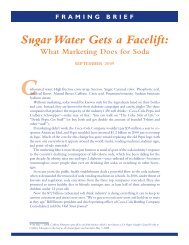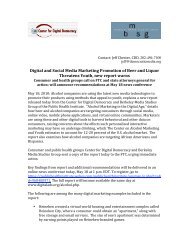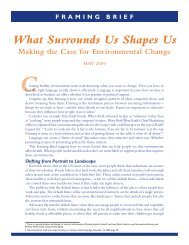"Interactive Food & Beverage Marketing" (PDF)
"Interactive Food & Beverage Marketing" (PDF)
"Interactive Food & Beverage Marketing" (PDF)
Create successful ePaper yourself
Turn your PDF publications into a flip-book with our unique Google optimized e-Paper software.
18<br />
<strong>Interactive</strong> <strong>Food</strong> & <strong>Beverage</strong> Marketing | Setting the Stage<br />
Today, food products figure prominently in how children and teens spend their<br />
own money and influence family spending. “Both parents and their children report that<br />
young people have the highest purchase influence on food, when compared with other<br />
nonfood spending categories,” noted the IOM report. 49 Sweets, snacks, and beverages<br />
account for a third of children’s direct purchases. 50 Teenagers spend 21 percent of their<br />
own money on food, reported Teenage Research Unlimited, “whether from drive-thrus,<br />
convenience stores or restaurants. On one level,” the market research company commented,<br />
“it’s obvious: they’re growing, and they’re always hungry. But more than that, eating<br />
represents one of the best ways for teens to gather with friends. Although many business<br />
owners and some malls discourage teens in groups, restaurants tend to be fairly<br />
obliging. Eating tends to be a very social activity for many teens.” 51<br />
Children’s media culture has also expanded dramatically during the past several<br />
decades. The rise of “kidvid” TV channels—such as Nickelodeon, Disney, FoxKids<br />
Network, and the Cartoon Network—increased both the number of outlets and the<br />
amount of programming available for children, offering marketers a variety of new opportunities<br />
for directly reaching this lucrative demographic group. With the launch of the<br />
World Wide Web in 1993, these networks began expanding their franchises onto the<br />
Internet and across a proliferating array of new digital platforms, joined by hundreds of<br />
new media ventures aimed specifically at children and teens. 52<br />
<strong>Food</strong> and beverage companies were among the earliest pioneers of digital marketing,<br />
harnessing the power of the Internet and other popular new media to target young<br />
people. In the mid-1990s, such major brands as Kellogg’s, Nabisco, Oscar Mayer,<br />
McDonald’s, and Frito-Lay launched websites, where they began developing a variety of<br />
techniques for directly interacting with children online. 53 Taco Bell launched a joint “multimillion<br />
dollar” venture with videogame company Nintendo in 1997; Pepsi forged a similar<br />
partnership with Sony. 54 In 1999, Jack in the Box created “Jack’s World,” an “interactive<br />
Internet playground loaded with fan-friendly freebies.” 55 The food industry was also heavily<br />
involved in early efforts to secure a stronghold for online advertising. In 1994, Procter<br />
& Gamble issued a “call to action” for marketers to begin focusing their attention on the<br />
Internet, and founded a new group four years later called the Future of Advertising<br />
Stakeholders (FAST), with the active participation of companies such as McDonald’s and<br />
Coca-Cola. 56









